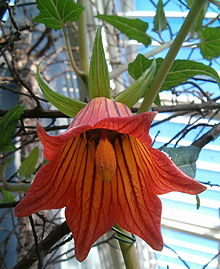Ornithophilia

Ornithophilia is the name given to the adaptation of flowers , the bird flowers , to pollination by birds . This form of pollination occurs mainly in the tropics and subtropics and occurs in most animal-pollinated plant families in the tropics. The numerically largest families of flower birds are the hummingbirds in the New World and the nectar birds and honey eaters in the Old World.
features
In plants, the adaptation manifests itself in the following bird flower syndrome:
- The flowers are often large and robust blooms or inflorescences. Mainly there are tubular, pharynx, bell, brush and flag flowers. Often they do not offer a chance to land, then pollination takes place in a buzzing or shaking flight.
- The flower color is usually red, often with a red-black contrast. There are also blue, yellow or green, but always luminous.
- The scent is weak or absent.
- The nectar is hidden to different depths. Nectar production is high and mostly takes place during the day, with the sugar content often being low.
The flower birds have a narrow, long, straight or curved beak. The tongue is deeply split, trough-shaped or tubular, its end is often brush-shaped or fringed. The nectar intake and pollination takes place in flight or you need a seat on parts of the flower, leaves or twigs. The pollen is usually transmitted on the head, less often on the beak or on the feet.
A special feature was at the South American tanagers ( passerines observed), the flowers of the genus Axinaea ( melastomataceae visit). These birds do not drink nectar, but instead eat parts of the stamens of the flowers. As a result, they activate a "bellows organ" in the stamen, with the result that their head is dusted by a pollen cloud. Visited a bird then to eat for another Stamen another bloom that adhering to it pollen come with the blossom scar in contact so that pollination comes about.
America
In America there are several families of birds that are flower birds:
- The hummingbirds (Trochilididae) occur from Alaska to Tierra del Fuego and pollinate, for example, fuchsias ( Fuchsia ), some cacti ( Schlumbergera ), cardinal lobelia ( Lobelia cardinalis ), American climbing trumpet ( Campsis radicans ). They take in the nectar in a whirlwind .
- The sugar birds (Coerebidae) and some representatives of the starfish (Icteridae) pollinate plants in Central and South America.
Old world
The nectar birds (Nectariniidae) in Africa, South Asia and Australia and the honeyeater (Meliphagidae) in Australia in the Pacific islands are the most important flower birds of the Old World. In Africa they pollinate the bird of paradise ( Strelitzia reginae ) and red-flowering aloe species. In tropical China, nectar and sunbirds pollinate ancient Hamamelidaceae (witch hazel family), and honey-eaters pollinate many Proteacees in Australia such as the species-rich genera Banksia and Grevillea , as well as the myrtle family (Myrtaceae). These have brush flowers, which are also visited by climbing marsupials. Callistemon and Melaleuca, for example, have cylinder brushes. The shaving brush flowers of Eucalyptus are pollinated by the brush-tongued parrots ( Trichoglossidae ). The spectacled birds (Zosteropidae) pollinate mainly Leptospermum and Acacia ( Acacia ). The Indomalay and Australian flower picks (Dicaeidae) pollinate Bauhinia , the panther birds (Pardalotidae) eucalyptus and acacias. The hawk birds endemic to Hawaii (Drepanididae) are closely tied to the likewise endemic lobelia ( Lobelia ).
There are no flower birds in Europe and North Africa. In the Canary Islands, however, there are two plant species with bird flower syndrome: Canary bellflower ( Canarina canariensis ) and Canarian foxglove ( Isoplexis canariensis ), but no designated flower birds. The two species are considered relics of the tertiary laurel forest, the original pollinators are likely to have died out during the ice ages. This ecological niche was filled with the Canary Bellflower by a subspecies of the Chiffchaff ( Phylloscopus collybita canariensis ) and a blackcap ( Sylvia conspicillata orbitalis ), with the Canary Foxglove by the Velvet Warbler ( Sylvia melanocephala leucogastre ).
Paleontological evidence
In May 2014, scientists from the Senckenberg Research Institute published a description of the fossil bird Pumiliornis tessellatus from the Messel pit , in whose well-preserved stomach contents large amounts of different flowering plant pollen were detected. The skeletal anatomy of the 47-million-year-old bird allows the conclusion that it was a nectar-sucking animal and that the pollen did not get into the stomach in any other way. The find is therefore the oldest evidence of ornithophilia to date. The next most recent evidence of fossil pollinators comes from the early Oligocene and is around 30 million years old.
literature
- Peter Leins: blossom and fruit. Morphology, history of development, phylogeny, function, ecology . E. Schweizerbart'sche Verlagsbuchhandlung, Stuttgart 2000, pp. 219, 237-239. ISBN 3-510-65194-4 .
Individual evidence
-
↑ Agnes S. Dellinger et al .: A Specialized Bird Pollination System with a Bellows Mechanism for Pollen Transfer and Staminal Food Body Rewards. In: Current Biology . Online pre-publication of July 3, 2014, doi: 10.1016 / j.cub.2014.05.056
New bird pollination mechanism discovered in South America. idw-online.de from July 4, 2014 - ↑ Gu et al .: Passerine pollination of Rhodoleia championii (Hamamelidaceae) in subtropical China . In: Biotropica . 42, No. 3, 2010, pp. 336-341. doi : 10.1111 / j.1744-7429.2009.00585.x .
- ↑ Gerald Mayr and Volker Wilde: Eocene fossil is earliest evidence of flower-visiting by birds. In: Biology Letters . Vol. 10, No. 5, 2014, 20140223, doi: 10.1098 / rsbl.2014.0223
- ↑ Ancient: Relationship Between Birds and Flowers. idw-online.de from May 28, 2014
- ↑ Gerald Mayr: Old World Fossil Record of Modern-Type Hummingbirds. In: Science . Vol. 304, No. 5672, 2004, pp. 861-864 doi: 10.1126 / science.1096856


